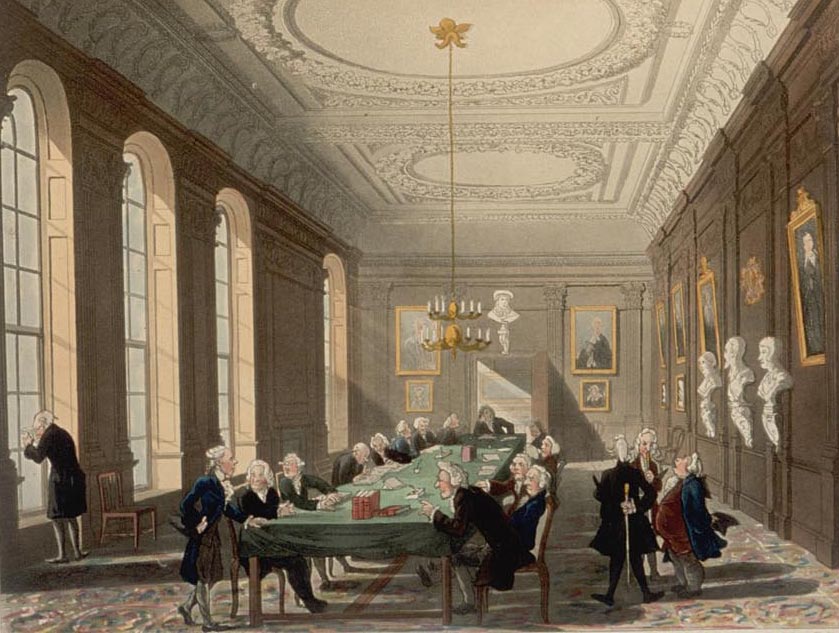|
Robert James Lee
Robert James Lee (9 November 1841, St James Parish, London – 17 November 1924, West Drayton, Middlesex) was an English physician. He published papers on diseases of children and on the "treatment of pulmonary phthisis by antiseptic vapours". Biography He had two younger brothers, James Irwin Lee (1843–1880) and John Francis Lee (1850–1905), both of whom graduated from the University of Cambridge. The father of the three brothers was the obstetrician Robert Lee, who held the chair of midwifery at St George's Hospital. After education at King's College School and Brighton College, Robert James Lee matriculated in May 1859 at Caius College, Cambridge. During his undergraduate years he was both a runner and an oarsman. He read natural sciences and graduated with a B.A. in 1863. After studying medicine in London at St George's Hospital and at St Thomas Hospital and in Paris, he graduated with his M.B. degree in 1865. In 1866 he qualified as M.R.C.P. In 1869 he graduated fr ... [...More Info...] [...Related Items...] OR: [Wikipedia] [Google] [Baidu] |
Westminster St James
Westminster St James (or St James Piccadilly) was a civil parish in the metropolitan area of London, England. The creation of the parish followed the building of the Church of St James, Piccadilly, in 1684. After several failed attempts, the parish was formed in 1685 from part of the ancient parish of St Martin in the Fields in the Liberty of Westminster and county of Middlesex. It included part of the West End of London, taking in sections of Soho, Mayfair and St James's. Civil parish administration was in the hands of a select vestry until the parish adopted the Vestries Act 1831. The vestry was reformed again in 1855 by the Metropolis Management Act. In 1889 the parish became part of the County of London and the vestry was abolished in 1900, replaced by Westminster City Council. The parish continued to have nominal existence until 1922. Creation There were attempts in 1664, 1668 and 1670 to create a new parish, with its own church, from the area of the bailiwick of St J ... [...More Info...] [...Related Items...] OR: [Wikipedia] [Google] [Baidu] |
Royal College Of Physicians
The Royal College of Physicians of London, commonly referred to simply as the Royal College of Physicians (RCP), is a British professional membership body dedicated to improving the practice of medicine, chiefly through the accreditation of physicians by examination. Founded by royal charter from King Henry VIII in 1518, as the College of Physicians, the RCP is the oldest medical college in England. The RCP's home in Regent's Park is one of the few post-war buildings to be listed at Grade I. In 2016 it was announced that the RCP was to open new premises in Liverpool at The Spine, a new building in the Liverpool Knowledge Quarter. The Spine opened in May 2021. History The college was incorporated as "the President and College or Commonalty of the Faculty of Physic in London" when it received a royal charter in 1518, affirmed by Act of Parliament in 1523. It is not known when the name "Royal College of Physicians of London" was first assumed or granted. It came into use aft ... [...More Info...] [...Related Items...] OR: [Wikipedia] [Google] [Baidu] |
Alumni Of Gonville And Caius College, Cambridge
Alumni (: alumnus () or alumna ()) are former students or graduates of a school, college, or university. The feminine plural alumnae is sometimes used for groups of women, and alums (: alum) or alumns (: alumn) as gender-neutral alternatives. The word comes from Latin, meaning nurslings, pupils or foster children, derived from "to nourish". The term is not synonymous with "graduates": people can be alumni without graduating, e.g. Burt Reynolds was an alumnus of Florida State University but did not graduate. The term is sometimes used to refer to former employees, former members of an organization, former contributors, or former inmates. Etymology The Latin noun means "foster son" or "pupil". It is derived from the Latin verb "to nourish". Separate, but from the same root, is the adjective "nourishing", found in the phrase '' alma mater'', a title for a person's home university. Usage in Roman law In Latin, is a legal term (Roman law) to describe a child placed in fostera ... [...More Info...] [...Related Items...] OR: [Wikipedia] [Google] [Baidu] |
People Educated At Brighton College
The term "the people" refers to the public or common mass of people of a polity. As such it is a concept of human rights law, international law as well as constitutional law, particularly used for claims of popular sovereignty. In contrast, a people is any plurality of persons considered as a whole. Used in politics and law, the term "a people" refers to the collective or community of an ethnic group or nation. Concepts Legal Chapter One, Article One of the Charter of the United Nations states that "peoples" have the right to self-determination. Though the mere status as peoples and the right to self-determination, as for example in the case of Indigenous peoples (''peoples'', as in all groups of indigenous people, not merely all indigenous persons as in ''indigenous people''), does not automatically provide for independent sovereignty and therefore secession. Indeed, judge Ivor Jennings identified the inherent problems in the right of "peoples" to self-determination, as i ... [...More Info...] [...Related Items...] OR: [Wikipedia] [Google] [Baidu] |
19th-century English Medical Doctors
The 19th century began on 1 January 1801 (represented by the Roman numerals MDCCCI), and ended on 31 December 1900 (MCM). It was the 9th century of the 2nd millennium. It was characterized by vast social upheaval. Slavery was abolished in much of Europe and the Americas. The First Industrial Revolution, though it began in the late 18th century, expanded beyond its British homeland for the first time during the 19th century, particularly remaking the economies and societies of the Low Countries, France, the Rhineland, Northern Italy, and the Northeastern United States. A few decades later, the Second Industrial Revolution led to ever more massive urbanization and much higher levels of productivity, profit, and prosperity, a pattern that continued into the 20th century. The Catholic Church, in response to the growing influence and power of modernism, secularism and materialism, formed the First Vatican Council in the late 19th century to deal with such problems and confirm ce ... [...More Info...] [...Related Items...] OR: [Wikipedia] [Google] [Baidu] |
1924 Deaths
Events January * January 12 – Gopinath Saha shoots Ernest Day, whom he has mistaken for Sir Charles Tegart, the police commissioner of Calcutta, and is arrested soon after. * January 20–January 30, 30 – Kuomintang in China holds its 1st National Congress of the Kuomintang, first National Congress, initiating a policy of alliance with the Soviet Union and the Chinese Communist Party. * January 21 – Alexander Cambridge, 1st Earl of Athlone, The Earl of Athlone is appointed Governor-General of the Union of South Africa, and High Commissioner for Southern Africa.Archontology.org: A Guide for Study of Historical Offices: South Africa: Governors-General: 1910-1961 (Accessed on 14 April 2017) * January 22 – R ... [...More Info...] [...Related Items...] OR: [Wikipedia] [Google] [Baidu] |
1841 Births
Events January–March * January 20 – Charles Elliot of the United Kingdom and Qishan of the Qing dynasty agree to the Convention of Chuenpi. * January 26 – Britain occupies Hong Kong. Later in the year, the first census of the island records a population of about 7,500. * January 27 – The active volcano Mount Erebus in Antarctica is discovered, and named by James Clark Ross. * January 28 – Ross discovers the "Victoria Barrier", later known as the Ross Ice Shelf. On the same voyage, he discovers the Ross Sea, Victoria Land and Mount Terror. * January 30 – **El Salvador proclaims itself an independent republic, bringing an end to the Federal Republic of Central America. **A fire destroys two-thirds of the city of Mayagüez, Puerto Rico. * February 4 – The first known reference is made to Groundhog Day, celebrated in North America, in the diary of a James Morris. * February 10 – The Act of Union (''British North America Act'', 1840) is proclaimed ... [...More Info...] [...Related Items...] OR: [Wikipedia] [Google] [Baidu] |
Henry Halford
Sir Henry Halford, 1st Baronet, GCH (2 October 1766 – 1844), born Henry Vaughan, was president of the Royal College of Physicians for 24 years. As the royal and society physician, he was physician extraordinary to King George III from 1793 to 1820, then as physician in ordinary to his three successors – George IV, William IV and the young Victoria. He also served other members of the royal family until his death. Early life Halford was born as Henry Vaughan at Leicester, the second but eldest surviving son of Dr. James Vaughan (27 March 1740 – 19 August 1813), an eminent physician at Leicester, and his wife, Hester (d. 2 or 7 April 1791), His brothers were Sir John Vaughan, judge; Peter Vaughan, Warden of Merton College, Oxford, and Dean of Chester; and Sir Charles Richard Vaughan, minister plenipotentiary to Switzerland and to the United States. He was educated at Rugby School, and there developed his love for classical literature. He went from Rugby to Christ Chur ... [...More Info...] [...Related Items...] OR: [Wikipedia] [Google] [Baidu] |
Erysipelas
Erysipelas () is a relatively common bacterial infection of the superficial layer of the skin ( upper dermis), extending to the superficial lymphatic vessels within the skin, characterized by a raised, well-defined, tender, bright- red rash, typically on the face or legs, but which can occur anywhere on the skin. It is a form of cellulitis and is potentially serious. Erysipelas is usually caused by the bacterium '' Streptococcus pyogenes'', also known as group A, β-hemolytic streptococci, which enters the body through a break in the skin, such as a scratch or an insect bite. It is more superficial than cellulitis and is typically more raised and demarcated. The term comes from the Greek ἐρυσίπελας (''erysípelas''), meaning red skin. In animals, erysipelas is a disease caused by infection with the bacterium '' Erysipelothrix rhusiopathiae''. In animals, it is called diamond skin disease, and occurs especially in pigs. Heart valves and skin are affected. ''E. rhus ... [...More Info...] [...Related Items...] OR: [Wikipedia] [Google] [Baidu] |
Phlegmasia Alba Dolens
Phlegmasia alba dolens (also colloquially known as milk leg or white leg; not to be confused with phlegmasia cerulea dolens) is part of a spectrum of diseases related to deep vein thrombosis. Historically, it was commonly seen during pregnancy and in mothers who have just given birth. In cases of pregnancy, it is most often seen during the third trimester, resulting from a compression of the left common iliac vein against the pelvic rim by the enlarged uterus. Today, this disease is most commonly (40% of the time) related to some form of underlying malignancy. Hypercoagulability (a propensity to clot formation) is a well-known state that occurs in many cancer states. The incidence of this disease is not well reported. Cause The disease presumably begins with a deep vein thrombosis that progresses to total occlusion of the deep venous system. It is at this stage that it is called phlegmasia alba dolens. It is a sudden (acute) process. The leg, then, must rely on the superficia ... [...More Info...] [...Related Items...] OR: [Wikipedia] [Google] [Baidu] |







